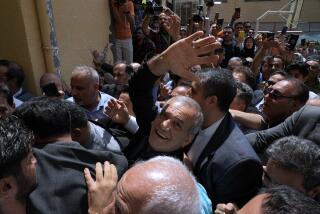Pre-Islamic icons symbolize Iran’s confused present
- Share via
TEHRAN — The advertising on the dry cleaner’s window said much about the conflicted identity of this nation where winged gods and glorious battles of ancient Persian kings are balanced against ayatollahs and an Islamic revolution that nearly 30 years ago brought morality police and martyrs.
Before the mullahs took charge in 1979, the dry cleaner was named Persepolis, the capital of the Persian Empire. That had the whiff of nationalism and the dry cleaner suddenly became the namesake of a revered cleric. The window today is an unreconciled collage where the names of Persepolis and the cleric coexist above a painting of spear tips and Achaemenian warriors.
There are few avenues for defiance in this Shiite Muslim nation, but one of them is in the past, where the emblems, folklore and images of old Persia mingle in quiet protest against the mullahs. The pre-Islamic era is alive in jewelry, architecture, decals, books, videos and websites that feature Cyrus the Great and gold-horned bulls.
“Our nation is not producing any new ideas or any new concepts,” said Baharak Keshani, an architect. “So what happens? Powerless minds imitate and we look back to the pre-Islamic times. We go to our history because the present is not glorious. The need to go back is a mixture of national pride and mysticism.”
Fascination with the pre- Islamic has run in trends since the 1979 revolution. Religious leaders first tried to blot out a past embraced by the man they overthrew, Mohammed Reza Shah. But they soon realized the appeal of Persian identity and now occasionally co-opt the past for tourism and national pride.
Unemployment, high inflation, political oppression and a distrust many Iranians have for President Mahmoud Ahmadinejad have stoked reflections on bygone centuries. And those who can afford it decorate their homes with nods to ancient Persian style: carved columns, mythical horses and visages of kings.
“It’s a psychological reaction to the Islamic regime,” said Naser Shahbazi, a drama teacher and bookseller, who sat in a shop of cracked bindings and dust. “Many Iranians hate the regime, but they’re scared. The pre-Islamic motif is the least dangerous way to express yourself. . . .
“One of my students was wearing a pendant of an image from ancient Persian times. I asked him, ‘Why are you wearing this?’ He said, ‘I like it.’ And I asked him, ‘Do you know the history of this?’ he said, ‘No.’ Much of it is just fashion for those who can afford it. Young men are wearing long hair like the ancient Achaemenian soldiers, and some strip Arabic words from their speech and speak pure Farsi. Sometimes I don’t understand them.”
The past is not fashion for Arash Abedi. He turned to the ancient two years ago on a trip to Persepolis, where he learned more about Zoroastrianism, a religion that fused the spiritual and natural worlds and predated Islam’s arrival from the Arabic world in the 7th century. Persian society rejected much Arab influence, which helped lead to the split between Sunni Arab countries and a Shiite Iran that wanted to keep its Persian roots.
The back window of Abedi’s taxi is painted with the winged god Fravahar, a half-man, half-bird who represents the eternity of the soul and whose rows of feathers symbolize the duality of good and evil.
“There is a backlash against Islamic culture,” Abedi said. “When I study pre-Islamic texts, I often find that Islam has taken from our Zoroaster history. So why not go to the original? When I give gifts now, I give a pendant or something that signifies the past.”
Farbod Jabahery’s jewelry store sells Fravahar pendants, mostly to young customers who have seen the emblem worn by expatriate, anti-government Iranian TV personalities beamed into this nation via satellite. The image of Fravahar was also extolled by the shah, an anti-Islamist who named streets after Persian kings and heroes.
“Bear in mind we were all Zoroastrians at one time,” said Jabahery, who is nervous about being perceived as talking against the Islamic regime. “We want to keep our roots. It’s a connection to our glory, but I don’t think there’s an anti- Islamic connotation to it. Many Iranian tourists from other countries buy these pendants to take back home with them.”
Keshani, the architect, knows more about symbols and their meanings than most. She sat in a cafe the other day, discussing how the Iranian government pulls the levers of the past to make people forget, at least for a moment, the problems of the present.
“The government selectively uses pre-Islamic history,” she said. “It depends on daily politics, like when they used it during the recent elections to say that we are a great nation with a great civilization. And then they turn it off and return to Islam. They use it for tourism too, but this same government neglects this heritage. Historical buildings . . . have gone to ruin. The past becomes a mask so you see us as I would like you to see us.”
What bothers her more, perhaps, are kitschy lions, winged gods and other icons of the past. They represent, she said, the confused soul of Iran and the conflict of blending what the nation was with what it has become.
“They suppose it’s a manifestation of the glorious past, but it’s not incorporated into the larger architectural scheme,” she said. “What you see in the city today is a vulgar representation of bad taste that has no harmony.”
--
More to Read
Sign up for Essential California
The most important California stories and recommendations in your inbox every morning.
You may occasionally receive promotional content from the Los Angeles Times.


![LOS ANGELES, CA - JUNE 17: [Cody Ma and Misha Sesar share a few dishes from their Persian Restaurant Azizam] on Monday, June 17, 2024 in Los Angeles, CA. (Ethan Benavidez / For The Times)](https://ca-times.brightspotcdn.com/dims4/default/7ffc7f6/2147483647/strip/true/crop/5110x3417+306+0/resize/320x214!/quality/75/?url=https%3A%2F%2Fcalifornia-times-brightspot.s3.amazonaws.com%2F79%2Fdc%2F4d29255545f5b9813315901692bc%2F1459972-fo-azizam-review20-eba.JPG)








